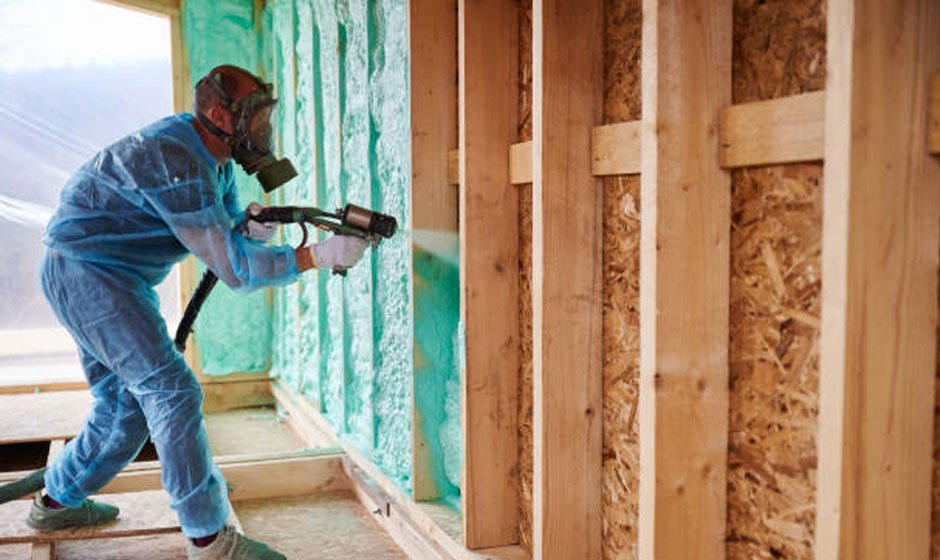In today’s fast-paced world, where environmental concerns are at the forefront, the quest for sustainable, healthy living spaces has become a priority. One key factor contributing to a healthier living environment is indoor air quality.
Poor indoor air quality can lead to many health issues, ranging from allergies to respiratory conditions. However, an innovative solution exists that not only enhances the thermal efficiency of your home but also significantly improves indoor air quality – spray foam insulation.
In this article, we will explore how spray foam insulation can be a breath of fresh air for your home and the environment.
What is Spray Foam Insulation?
Spray foam insulation is a high-performance material applied as a liquid to walls, floors, and ceilings. The liquid quickly expands and hardens, creating an airtight seal that helps to block out external pollutants, allergens, and moisture. It prevents air leaks and heat transfer more effectively than traditional insulation materials such as fiberglass or cellulose.
Improved Air Quality with Spray Foam Insulation
One of the main advantages of spray foam insulation is its ability to create a barrier against outside elements that can compromise indoor air quality. This includes dust, pollen, pollutants, and other allergens that can enter through cracks and gaps in traditional insulation. By creating an airtight seal, spray foam effectively removes these contaminants, improving indoor air quality.
Moreover, spray foam insulation is free of harmful chemicals such as formaldehyde and volatile organic compounds (VOCs), commonly found in other insulation materials. These chemicals can release toxins into the air, contributing to poor indoor air quality and potential health concerns. Choosing spray foam insulation can help reduce exposure to these harmful substances.
Energy Efficiency and Indoor Air Quality
In addition to improving indoor air quality, spray foam insulation provides excellent thermal resistance. By sealing all air leaks, you keep your home at a consistent temperature, reducing the need for constant heating or cooling. This energy efficiency not only saves you money on your utility bills but also helps reduce your home’s carbon footprint, contributing to a healthier environment.
Other Benefits of Spray Foam Insulation
Aside from improving indoor air quality and increasing energy efficiency, spray foam insulation offers many other benefits. It’s highly durable, providing long-term protection against air and moisture intrusion. It also adds structural strength to your home, making it more resistant to wind and other external elements.
Moreover, spray foam insulation is an eco-friendly choice. It has a high R-value (a measure of thermal resistance), meaning you can use less material while still achieving the same level of insulation as traditional materials. This results in less waste and a smaller carbon footprint.
Additional Factors to Consider
While spray foam insulation offers extensive benefits for improving indoor air quality and energy efficiency, several additional factors warrant consideration:
- Installation Process: Proper spray foam insulation installation is critical to its performance and safety. Professional expertise is required to ensure the foam is applied correctly and uniformly, avoiding any gaps or overspray. Incorrect installation can lead to inadequate insulation or health risks if the materials are improperly handled correctly.
- Cost Implications: Initially, spray foam insulation can be more expensive than traditional insulation materials. The higher upfront cost is due to the materials and the need for skilled installation. However, the long-term savings on energy bills and the product’s durability often offset the initial investment over time.
- Health and Safety During Installation: Proper ventilation and personal protective equipment (PPE) are vital during the application of spray foam insulation. The chemicals used in the installation process can release harmful gases during and immediately after application. Following safety guidelines can mitigate health risks.
- Building Codes and Regulations: Different regions have various building codes and regulations related to insulation. Before installing spray foam insulation, verifying that the product meets local codes and that the installation process complies with all relevant regulations to avoid potential legal issues is essential.
- Environmental Considerations: While spray foam insulation can reduce a building’s carbon footprint by improving energy efficiency, the environmental impact of the chemicals used in its production and application is a consideration. Opting for lower global warming potential (GWP) products and ensuring proper installation can minimize environmental concerns.
Potential Spray Foam Drawbacks
- Initial Cost: Despite its long-term benefits, the initial cost of spray foam insulation is higher than traditional insulation options.
- Professional Installation Required: Professional installation by certified technicians is necessary to ensure safety and effectiveness.
- Sensitive Installation Process: Incorrect application can lead to gaps or overspray, reducing the insulation’s effectiveness and potentially causing health risks.
- Chemical Sensitivity: Individuals with chemical sensitivities may react to the compounds used during the spray foam insulation.
- Limited Retrofit Options: Installing spray foam insulation in existing structures can be more challenging than in new constructions.
- Environmental Impact of Chemicals: The production and application of spray foam insulation involve chemicals that may hurt the environment. Proper handling and disposal are essential.
How to Install Spray Foam Insulation
Installing spray foam insulation is a detailed process that requires expertise and precision. It’s strongly recommended that you seek the services of professional installers trained and certified in safely handling materials and equipment. Here are the general steps involved, underlining the necessity for professional involvement:
- Preparation: Before installation begins, professionals will prepare the area by removing any old insulation material and ensuring the space is clean and dry. This step may involve addressing issues affecting the application, such as leaks or damage to the structure.
- Safety Measures: Professional installers will wear protective gear, including masks, goggles, and gloves, to protect themselves from the chemicals in the spray foam. They will also ensure the area is well-ventilated to safeguard against the inhalation of fumes.
- Mixing the Chemicals: Spray foam insulation is made by mixing two chemicals. Professionals do this mixing onsite, using special equipment to achieve the correct ratio necessary for the foam to expand and cure properly.
- Application: The mixed foam is applied to the designated areas using professional-grade spraying equipment. Skilled technicians ensure even coverage, paying careful attention to gaps, crevices, and hard-to-reach spots to create an airtight seal.
- Curing: After application, the foam quickly expands and cures over several hours. During this time, it is crucial to keep the area ventilated and avoid any contact with the foam.
- Inspection and Cleanup: Once the foam has fully cured, professionals will inspect the installation to ensure completeness and effectiveness. They will also conduct a thorough cleanup, removing overspray and ensuring the area is safe for re-entry.
- Final Assessment: A final evaluation may confirm the insulation’s performance, including checks for air leaks and thermal imaging to ensure no spots were missed.
Given the complexity and the potential health hazards involved in the installation process, professional installation is not just advised but essential for ensuring the safety and effectiveness of spray foam insulation. Attempting DIY installation without the necessary skills and equipment can lead to inadequate insulation, health risks, and potential legal issues.
Conclusion
Spray foam insulation offers a range of benefits, including energy efficiency, durability, and improved indoor air quality. However, it’s essential to consider potential drawbacks such as initial cost and environmental impact before deciding to install spray foam insulation.
Insulation professional services are necessary to ensure safety and effectiveness, highlighting the importance of seeking certified and trained technicians. By understanding spray foam insulation’s benefits and potential limitations, individuals can make an informed decision and reap the long-term rewards of this innovative insulation option.






